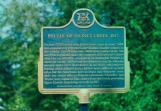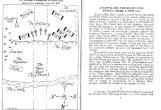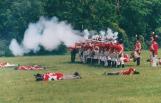1
One hundred and ninety years ago, a battle was fought on the grounds where Battlefield Park is situated today. This conflict took place in the middle of the night, which meant that neither side could see more than the shadows of those they fought. The only light came from campfires and the flashes of the musket and cannon. This battle was a turning point in the course of the War of 1812.2
Song written about the Battle of Stoney Creek, written by Woody Lambe, performed by the Lowlanders.1960

3
"The Stoney Creek Song"Written by: Woody Lamb
Performed by: The Lowlanders
'Twas in 1813 the Yankees come
Acting out orders from Washington
Crossed the Niagara, quite a feat
When they marched on the town of Stoney Creek
Now little Billy Green was getting into bed
When out of his window he poked his head
Saw those Yankees marching down the street
Said, "Mom there's some Yankees in Stoney Creek!"
Now his mom said, "Billy boy, you better run.
Hightail straight down to Hamilton
Colonel Harvey is the man to ask,
Tell him that he better get down here fast!"
And if he asks why you look so weak,
Tell him that the Yankees are in Stoney Creek.
So Bill took off and he ran all the way
Hopped the Canadians at Hamilton Bay
Reached their lines all weary and pale
Then he found Colonel Harvey and he told him his tale
Now Harvey turned around and he said to his men
"Boys, looks like we're going to have to fight again.
If we leave now we'll catch them by surprise,
And they'll never get a glance of the whites of our eyes."
So they packed up their gear and they marched through the night
And jumped those Yankees about midnight
They were enjoying a final snore
But they woke up fast to the firelocks roar
As they reached for the guns they were heard to speak
"How the hell did the British get to Stoney Creek?"
Now they fired a few shots then turned around and ran
And they headed right back to their native land
The redcoat boys were having a ball
And they chased them all the way to Niagara Falls
Now the Yanks have fought in some famous wars
On many a battlefield of blood and gore
And I don't think their forces have looked so weak
As the day they got chased out of Stoney Creek.
And if you don't believe where of I speak,
Go down and see the monument in Stoney Creek. (x2)
4
Plaque erected by the Archaeological and Historic Sites Board of Ontario.1999
Battlefield Park, Stoney Creek, Ontario

5
After crossing the Niagara River and capturing Fort George, the American army was poised for its main invasion of Upper Canada. Greatly outnumbered, the only hope the British had was a surprise night attack. With the American camp poorly set out and the password given to them by local hero Billy Green, General Vincent and Lt. Col. Harvey agreed to attack under the cover of darkness.7
Young Billy Green is said to have been the first white child born in Stoney Creek. At the time of the Battle of Stoney Creek, he was nineteen years old. Always one to roam the woods, he had no fear.The following exerpt is from his own recod of that fateful day:
"Isaac gave the countersign to me; I got it and away I came. When I got up the road a ways I didn't know what to do; so I pulled my coat over my head and trotted across the road on my feet and hands like a bear.
"I went up the hill to Levi's house and got Levi's old horse Tip and led him along the Mountain side until I could get to the top. Then I rode him away around by the gully where I dismounted and tied old Tip to the fence and left him there, making my way on foot to Burlington Heights.
"When I got there they took me for a spy, and I had to tell them all I knew before they would believe me. I explained to Col. Harvey where and how the American army were encamped near Stoney Creek. He suggested a night attack on the enemy. After a short interview with General Vincent they decided to start at once for Stoney Creek and everyone commenced to hustle."
9
To attack the American army of 3,000, Harvey had only about 700 troops, drawn from the 8th and 49th Regiments, and a small detachment of local Gore militia. This force moved off from their base at Burlington Heights (near present day Dundurn Castle) at midnight, led by Billy Green, who was familiar with the local paths. Moving along what is present day King Street, the British were in position at approximately 2:00am. The main strike would approach the centre of the American camp, located near Smith's Knoll.10
A map of the American encampment at Stoney Creek, from the booklet 'Battle for the Heartland'.1969

11
The Americans posted an advance sentry at the Meeting House, which was located near present day King Street, where the Stoney Creek cemetery remains today. The British bayoneted two sentries, but their luck ran out when a third was able to fire his musket, waking the American camp.12
British reenactors during the Reenactment of the Battle of Stoney Creek.1998
Battlefield Park, Stoney Creek, Ontario

13
With the element of surprise lost, the British troops surged forward en masse, yelling and shouting, making it difficult for their officers' orders to be heard. Quickly alerted, the Americans wisely formed a line in front of their main camp. The British rushed up to the American encampment, situated between present day Highway 20 and Battlefield Creek. As a result of the confusion of the night, no proper assault could be developed, and the ensuing firefight degenerated into combat between sections, companies, even individuals. All fought in complete darkness, with both sides standing their ground. American generals Winder and Chandler became so confused that they stumbled into the British line and were promptly made prisoners. Eventually, the British were able to capture two American cannons at Smith's Knoll. Realizing daybreak would reveal their inferior numbers, the British made their way back to Burlington Heights, taking with them their captured prizes.14
At daybreak, the Americans retreated to Forty-Mile Creek (Grimsby). Being further harassed there, they retreated all the way back to Fort George, leaving in such a hurry that a considerable amount of their belongings were left behind.Not since then has an invading army ventured so far into the Niagara Peninsula.

